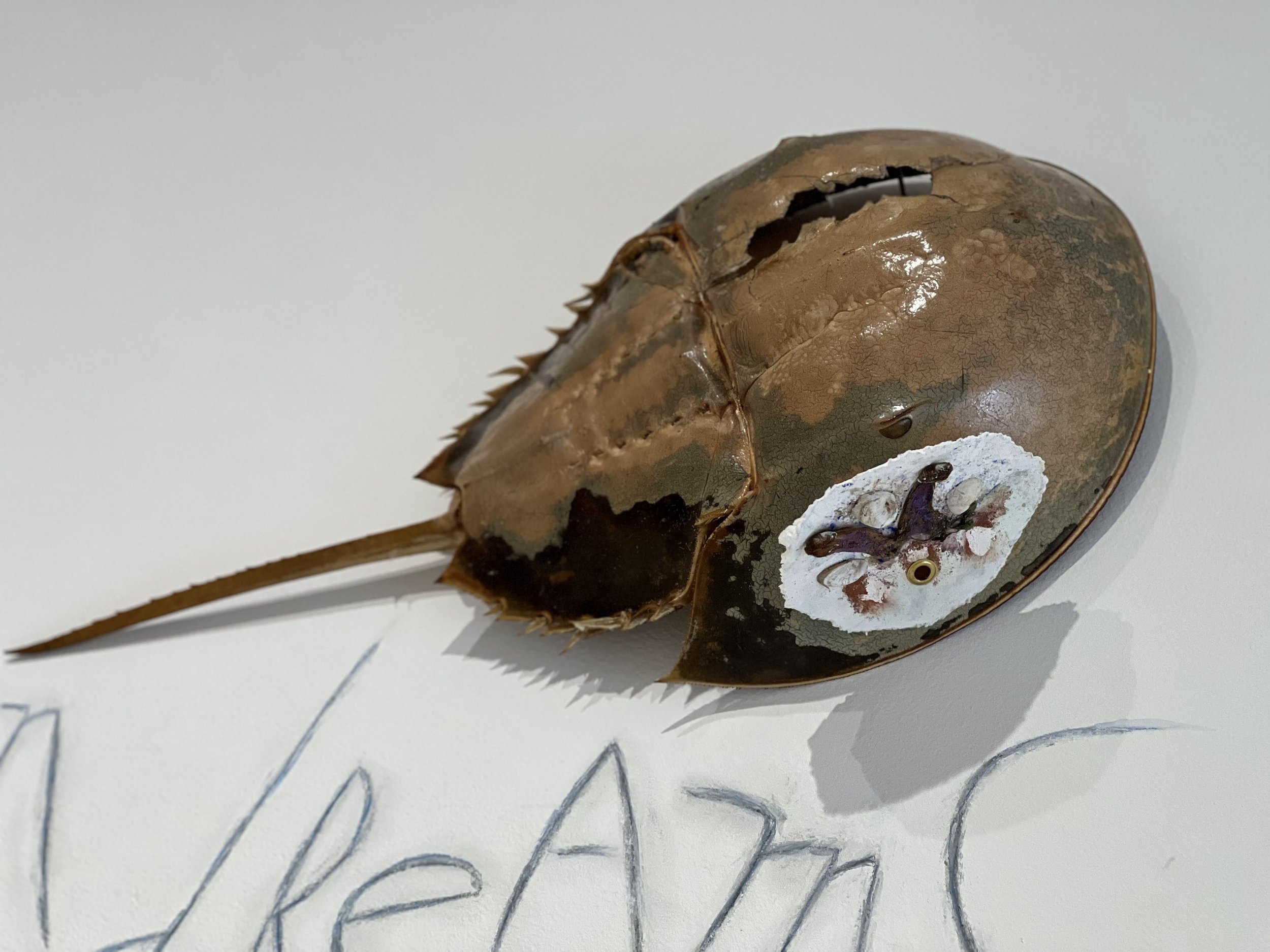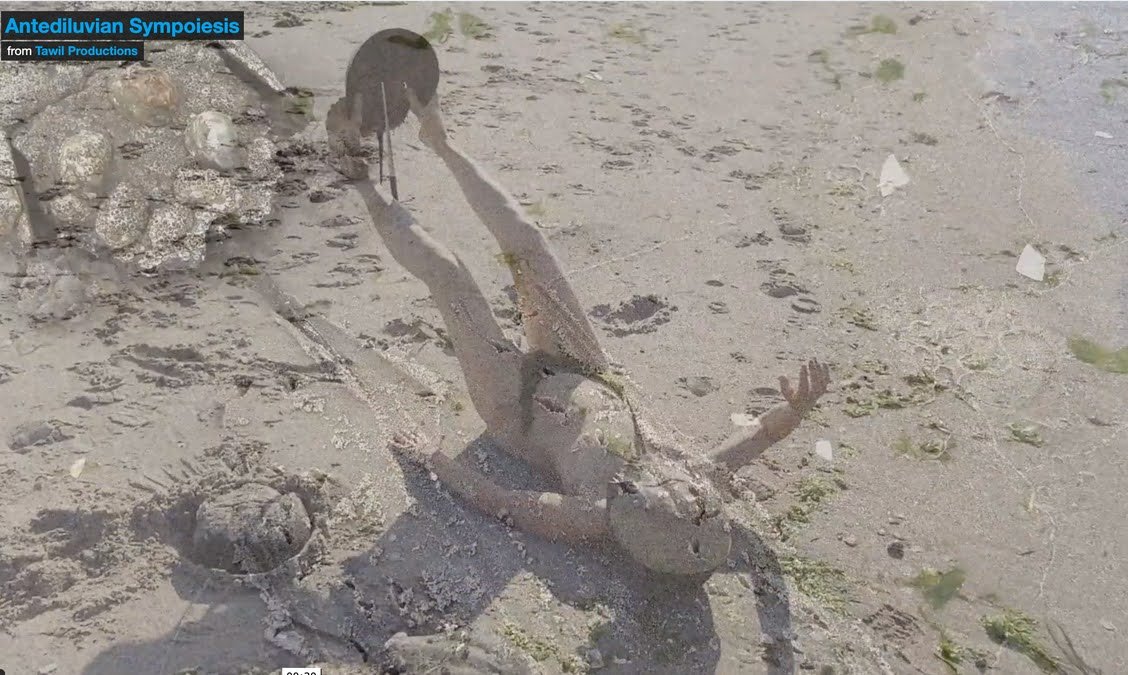Nicole Peyrafitte
Antediluvian Sympoiesis
—A Multimedia Installation
Text & Image
“Antediluvian Sympoiesis” is an installation originally created for the exhibition Women and Other Wild Creatures: Matrilineal Tales at Sapar Contemporary Gallery in New York City. In its original gallery form, it was curated by Nina Levent between June 4 and August 25, 2022. The mixed-media installation—one video, one text hand-painted on the wall, two notebooks, one photograph and three paintings on/in Limulus Polyphemus (horseshoe crab) shells—initiated an environment on art’s response and ability as healing practice, featuring the materiality of the natural world. Its reincarnation via these internet pages of Chant de la Sirene seeks to mirror the gallery version’s ethos.
BACKGROUND
Since 2011 Karstic-Actions1 have been the main focus of my artistic activity. These works explore proprioception (sense of body position) & kinesthesia (sense of body movement), as meeting points between painting, poetry, voice & improvised music. They have also at times integrated food elements. From making crêpes, whipping cream or soups to serving full dinners, sharing food with the audience has been part of my performance repertoire since the ‘90s. The search for sustainability of body and mind is the work’s quest: family, art, food, nature observation, physical fitness— all are treated with the same intensity while trying to keep health as the central axis. By “health,” I mean taking the word at its core sense:
”HEALTH: Old English hælþ, "wholeness, a being whole, sound or well," from Proto-Germanic hailitho, from PIE kailo, meaning "whole, uninjured, of good omen" (source also in the Old English hal, meaning "hale, whole"; also, Old Norse, heill, "healthy"; and Old English halig, Old Norse helge "holy, sacred"; Old English hælan "to heal"). With Proto-Germanic abstract noun suffix *-itho (see -th [2]). Of physical health in Middle English, but also "prosperity, happiness, welfare; preservation, safety." An abstract noun “to whole,” not to heal. Meaning "a salutation" (as in a toast, etc.), wishing one welfare or prosperity (from 1590s. “Health” food is from 1848). -th [2] is a suffix forming nouns of action, a state, or quality out of verbs or adjectives (such as depth, strength, truth), from Old English -ðu, -ð, from Proto-Germanic *-itho (cognates: Old Norse -þ, Old High German -ida, Gothic -iþa), abstract noun suffix, from PIE *-ita (cognates: Sanskrit -tati-; Greek -tet-; Latin -tati-, as in libertatem "liberty" from liber "free"). Sometimes in English reduced to -t, especially after -h- (as in height).
*
Many things can change the dynamic & outcome of our practices; for example, during the early days of the pandemic confinement my response was to broadcast 24-hour live, 30-minutes each, the making of very healthy home-cooked meals from scratch. I was born—literally!—and raised in my family’s hotel-restaurant in Southern France, where I did run the kitchen as the chef for a few years. Cooking is thus in my “nature.” I have done it since I was six years old. With poet and husband Pierre Joris as my side-kick, our kitchen became a cooking studio. While cooking these daily meals live, we also provided practical, historical and dietetic information. I didn’t think about it at the time, but this action fits the core definition of the word health: "prosperity, happiness, welfare, preservation, safety.”
Then life somehow resumed and we were able to go to Europe to install an art show, entitled, “Nicole Peyrafitte & Pierre Joris’ KARSTIC ACTIONS/WORKS,” June 4 through July 15, 2021. Like many such events, this exhibition had been delayed by the pandemic, but in late May 2021 we finally could travel to install it on all three levels of Galerie Simoncini in Luxembourg 5. Domopoetics is the name we give to the daily practice of transformation of and in our works, be that writing, painting, video, physical conditioning, or in our shared household and familial activities. “Karstic" is a term that refers to the geological phenomena of dissolution and transformation at work in the formation of superficial or underground limestone topographies. By a similar principle of infiltration, language transforms into poem, breath into song, and colored chalk become pastel into marks on paper or canvas.
Recently, new family health issues refocused my work into a more intimate, private practice. As we were talking about this upcoming exhibition, Nina Levent was sensitive to this aspect of my current work. She accurately pointed out that my practice was a healing journey. Indeed, I find comfort and purpose in deepening connections with other-than-human voices, like birds, horseshoe crabs, water & elements of landscape.
INSTALLATION ELEMENTS
• 1 video
• 1 hand-painted text on the wall
• 2 sketchbooks
• 3 paintings on/in Limulus Polyphemus shells + 1 photograph
My Antediluvian Sympoiesis installation samples these current investigations & delineates art’s healing response-ability.
When Levent was planning the show, we were in the Spring of 2022, and war had just started raging in Ukraine, where she is from and her family still lives. She was clear that the exhibition was meant to have a healing perspective. When we discussed potential ideas, birds and horseshoe crabs came up. It was the spawning season of Limulus Polyphemus —a.k.a. the “horseshoe crab,” which in fact is not a crab! Sympoiesis, or “making-with,” is an asana that requires constant practice. This poem is a memento and I often perform it during my live Karstic-actions. Painting it on the wall emulates Limulus Polyphemus’ tracks on the sand.
VIDEO
The video was the last piece created. Again, it was Limulus Polyphemus spawning season and, like every year, I went to Plumb Beach—in Brooklyn and only 20 minutes away from where I live—to once again witness this remarkable event. At full moon and high tide, thousands of these creatures crawl out of the depth of the ocean where they dwell to lay their eggs on the sandy beaches of the Atlantic Ocean. On May 21, 2022, during one of my several spring trips to Plumb Beach, I felt the urge to document myself lying among the multi-millennial arthropods. I brought a couple of shells that I had previously collected (both now in the installation). Since Limulus Polyphemus has 10 eyes I thought it made sense to place my iPhonePro inside the beautiful female shell—which is in the show and now bears this line from my poem: “reliable emergence tidal connection.” Additional footage was taken by Joris, who was assisting me.
What happened next was very instinctual and driven by the desire for a close physical association. I truly felt the symbiosis of depth, strength, truth—all words with the suffix -th (2)—pertaining to health and spawning me, too. That is when the title “Antediluvian Sympoiesis" imposed itself, pointing to a “making-with” that predates Biblical times. “Sympoiesis” is a term coined by Donna Haraway in Staying with the Trouble: Making Kin in the Chthulucene, and which she defines it as “a word proper to complex, dynamic, responsive, situated historical systems. It is word for worlding-with, in company.”
In her paper “Healing in the Chthulucene: Becoming Beyond Human with Medicinal Plants” political ecologist Laura Dev writes:
Donna Haraway’s concept of the “Chthulucene” is used as an alternate lens to the Anthropocene, which highlights the inextricable linkages between humans and other-than-human species. Healing can be viewed as a type of embodied orientation or engagement with the world, which has the potential to reach across boundaries of the skin, blur distinctions between self and other, and allow for both transpersonal and trans-species reconciliation.
Dev focuses on plant-healing practices by natives of the Peruvian forest, but her observations can be applied to any surroundings comprising nature and other-than-human earthlings. Thus the short edited video of the (inter-)actions with the Limulus on the beach instances the interconnectedness between horseshoe crabs, birds migration and taking the time to dwell in their/our speeds and slownesses. It is essential for me to avoid dwelling within the “mostly-dead world” and rather help heal with those “alive and inhabited by other selves.”
TEXT PAINTED ON THE WALL
Acceptance
of a past
returning in dreams
as a liminal
other-than-human
shaped consciousness
half prey
half me
they fix me
they love me
I too love them
for ever
yet
I never met them
I first wrote a version of this poem in 2009 and this text keeps evolving. A version was published in my book Bi-Valve:Vulvic-Space/Vulvic-Knowledge, and recorded with Michael Bisio on double bass (https://soundcloud.com/nicole-peyrafitte/12-crane). Cranes (as in the recording), other birds, and more recently Limulus Polyphemus—or just observing nature—all spark my imagination; they always reveal the outline of what response-ability and tying human and nonhuman ecologies can become. This poem is a memento, and I often perform it during my live Karstic-actions. It had to become a painting emulating Limulus Polyphemus’ tracks on the sand.
SKETCHBOOKS
My sketchbooks are my mementos. I draw/write/mark and make notes about what I see, read, listen to, question, study and/or want to remember. Shown in “Antediluvian Sympoiesis" is my latest finished carnet, a double-sided leporello Connection en Mille-Feuille that was just published by Red Fox Press. It was my daily companion from November 21, 2021, to February 13, 2022.
I have seen, photographed and learned something from and about all the birds and subjects drawn on these pages. The writings—when not my own—quote books and lectures by Haraway, Suzanne Simard, Maureen Raymo, Betsy Damon, Native American dictionaries and history books, as well as geological studies of where I dwell, that is, the tip of the Bayridge terminal moraine and the shores of New York City.
PAINTINGS & PHOTOGRAPH
3 paintings on/in Limulus Polyphemus shells.
Limulus #2: Horseshoe crab shell (with sanderling photograph next to it)
Text painted w/ gouache: “reliable emergence tidal connection,” a note from a 2020 sketchbook taken at Plumb Beach during the 2020 migration and spawning season. This shell was the one held up between my feet with the iPhone camera inside.
A Sanderling:
Sanderlings are small shore wading migratory birds. In spring, like many shore birds migrating north from South America, sanderlings, ruddy turnstones (the bird in the video), red knots consume large amounts of horseshoe crab eggs rich in proteins, essential nourishment for these birds, some of which will travel thousand of miles to High Arctic breeding grounds.
Limulus #3:
Horseshoe crab shell with painting inside and the epibionts that were on it when the Limulus was found dead on the beach. Other organic elements of the painting were found at Owl’s Head Park (tip of the Terminal moraine).
Limulus #1:
Horseshoe crab shell & mixed media: This shell was used as a “mask” in the video and the organic elements of the painting also come from Owl’s Head Park. I tagged the round little painting onto the shell to mirror and emulate the program conducted by the US. Fish & Wildlife Service. Every spawning season trained volunteers walk the beach at high tide to collect valuable information. Limulus are counted, observed, and some are tagged with a small numbered disc, before being released back into the ocean. The information about these is documented and one is encouraged to report the number. This information is entered into a database that records their movements year after year. You can see a couple of such tagged Limulus in the video.
The layering of these elements establishes an unfathomable scale of presence on earth: 450 million years for Limulus Polyphemus and 35 million years for the shore birds, while the final form of the terminal moraine and the shore delineation reach back 13 million years. The shores I dwell on are all thus antediluvian formations, with homo sapiens a very recent apparition. This brief summary reveals the symbiotic complexities of this eco-system. “Antediluvian Sympoietic” “makes-with” beyond the Biblical. It is my art’s response-ability as healing practice.

